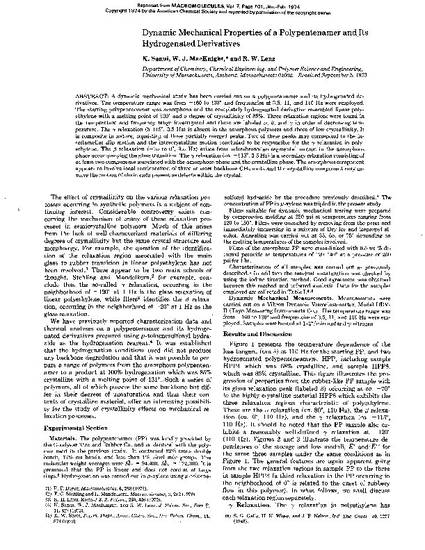
Article
Dynamic Mechanical Properties of a Polypentenamer and Its Hydrogenated Derivatives
Macromolecules
(1974)
Abstract
ABSTRACT: A dynamic mechanical study has been carried out on· a polypentenamer and its hydrogenated derivatives. The temperature range was from -160 to 130° and frequencies of 3.5, 11, and 110 Hz were employed. The starting polypentenamer was amorphous and the completely hydrogenated derivative resembled linear polyethylene with a melting point of 130° and a degree of crystallinity of 85%. Three relaxation regions were found in the temperature and frequency range investigated and these are labeled a, {:J, and -y in order of decreasing temperature. The a relaxation (5-115°, 3.5 Hz) is absent in the amorphous polymers and those of low crystallinity. It is composite in nature, consisting of three partially merged peaks. Two of these peaks may correspond to the interlamellar slip motion ad the intracrystalline motion concluded to be responsible for the -y relaxation in polyethylene. The f3 relaxation ( -75 to 0°, 3.5 Hz) arises from microbrownian segmental motion in the amorphous phase accompanying the glass transition. The -y relaxation ( ca. -115°, 3.5 Hz) is a secondary relaxation consisting of at least two components associated with the amorphous phase and the crystalline phase. The amorphous component appears to involve local reorientation of three or more backbone CH2 units and the crystalline component may involve the motion of chain ends present as defects within the crystal.
Keywords
- Properties,
- Dynamic,
- Polypentenamer,
- Hydrogenated Derivatives
Disciplines
Publication Date
1974
Citation Information
William MacKnight, K. Sanui and R. W. Lenz. "Dynamic Mechanical Properties of a Polypentenamer and Its Hydrogenated Derivatives" Macromolecules Vol. 7 (1974) p. 101 - 105 Available at: http://works.bepress.com/william_macknight/40/
